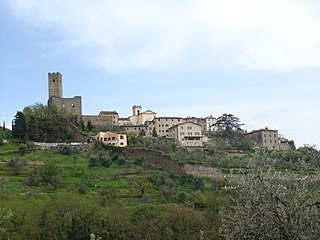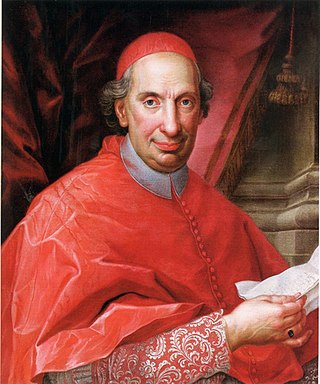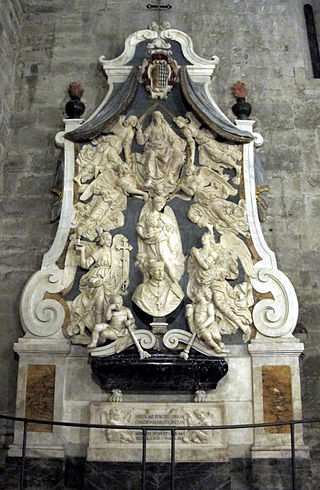The Biblioteca Fabroniana is a public library, founded in 1726, and located on Piazzetta San Filippo #1 in Pistoia, region of Tuscany, Italy.
Contents


The Biblioteca Fabroniana is a public library, founded in 1726, and located on Piazzetta San Filippo #1 in Pistoia, region of Tuscany, Italy.


The library was founded in 1726 in a site adjacent to the church of Santi Filippo e Prospero. The basis of the collection was the library of the Cardinal Carlo Agostino Fabroni. [1] [2] Refurbishment of the building to hold the library began in 1722; the endowment conditioned that the library "always and forever serve with ease the public needs of the city. [3] The cardinal's collection was transported from Rome to Livorno by two galleys commissioned by Pope Benedict XIII, and then overland to Pistoia. The library was first housed and administered by the Pistoiese Oratorian congregation. It was open to the public in 1730 and competed with the other large library of Pistoia, the Biblioteca Forteguerriana.
In 1810, following the suppression of the Oratorians, the administration moved to the City, and after the fall of the Napoleonic regime, to the Chapter of the Cathedral Chapter, as envisaged in the bequest of Fabroni. The Cathedral still manages the facility. [4]
The building was refitted to make a library by Francesco Maria Gatteschi. The portal with the superiorly concave tympanum consisting of two half-arches, nestles the coat of arms of Cardinal Fabroni. [5] The staircase entrance is decorated with quadratura frescoes, and opens to a large reading room, dominated by a statue of the cardinal by Gaetano Masoni. On either side of the entrance are two marble sculptures, depicting the "Birth" and "The Deposition" by Augusto Cornacchini. The scroll above the door threatens the curse of excommunication to any that steals a book from the room. [6] The book stacks are two stories high, and at each corner of the room is a small reading cubicle.
The library was further enlarged in 1869 by the Countess Eugenia Caselli, the last female descendant of the Fabroni family, in 1917 by the collection of the Pistoiese lawyer Tommaso Gelli and by the addition of collections from both the Oratorions and Franciscans from the Giaccherino. Assets now include nearly 20,000 printed volumes, including precious incunabula and over 400 manuscripts.
The cardinals collection included nearly 2,400 folios, 1,800 quartos, and 2,460 sesti; the collection covered subjects of theology, philosophy, history, geography, mathematics, and philology. It was notable for including books under censure by the Church, but accessible to the cardinal by virtue of his post as Secretary of the Propaganda Fide. The library collections now cover the works of the Fathers of the Church; ecclesiastical histories; rules of monastic orders; hagiographic works of the Sacred Rota; documents on Jansenism; the Council of Trent; and the Bolla Unigenitus for which Fabroni was a major author, and which censured Jansenism. Besides these, there is an important collection dedicated to the Catholic Jesuit missions in China, works of medicine, physics, natural sciences, arithmetic and geometry. [7]

Pistoia is a city and comune in the Italian region of Tuscany, the capital of a province of the same name, located about 30 kilometres (19 mi) west and north of Florence and is crossed by the Ombrone Pistoiese, a tributary of the River Arno. It is a typical Italian medieval city, and it attracts many tourists, especially in the summer. The city is famous throughout Europe for its plant nurseries.
Unigenitus is an apostolic constitution in the form of a papal bull promulgated by Pope Clement XI in 1713. It opened the final phase of the Jansenist controversy in France. Unigenitus censured 101 propositions of Pasquier Quesnel as:
false, captious, ill-sounding, offensive to pious ears, scandalous, pernicious, rash, injurious to the Church and its practices, contumelious to Church and State, seditious, impious, blasphemous, suspected and savouring of heresy, favouring heretics, heresy, and schism, erroneous, bordering on heresy, often condemned, heretical, and reviving various heresies, especially those contained in the famous propositions of Jansenius.

Larciano is a comune (municipality) in the Province of Pistoia in the Italian region of Tuscany. The town hall is located in San Rocco.

The Church and Convent of the Girolamini or Gerolamini is a church and ecclesiastical complex in Naples, Italy. It is located directly across from the Cathedral of Naples on via Duomo. The facade is across the homonymous piazza and street from Santa Maria della Colonna. It is one block west of Via Duomo.

The Biblioteca Casanatense is a large historic library in Rome, Italy, named in honour of Cardinal Girolamo Casanate (1620–1700) whose private library is at its roots.

Jacopo Zoboli, also known by Giacomo, was an Italian painter of the Baroque style.

The Biblioteca Comunale degli Intronati is the public library located at Via della Sapienza #3 of the comune of Siena, in Tuscany, Italy.

The Biblioteca Nazionale Braidense or Braidense National Library, usually known as the Biblioteca di Brera, is a public library in Milan, in northern Italy. It is one of the largest libraries in Italy. Initially, it contained large historical and scientific collections before it was charged with the legal deposit of all publications from Milan. Since 1880, it has had the status of a national library and is today one of the 47 Italian State libraries.

The House of Rospigliosi is an ancient noble Italian family from Pistoia. Attested since the Middle Ages, it became wealthy through agriculture, trade and industry, reaching the apogee of its power and the high nobility status in Rome thanks to Giulio Rospigliosi, elected pope in 1667 with the name of Clement IX.

Carlo Agostino Fabroni was an Italian Roman Catholic cardinal.

The Biblioteca Queriniana is a public library with a rich collection of ancient manuscripts, located on Via Giuseppe Mazzini in Brescia, region of Lombardy, Italy. The library was founded in 1747 and owes the nucleus of its collection to Cardinal Angelo Maria Querini (1680–1755).

The Marucelliana Library or Biblioteca Marucelliana, is a public library, founded by the mid-18th century, and located on Via Camillo Cavour # 43, in Florence, region of Tuscany, Italy.
The following is a timeline of the history of the city of Pistoia in the Tuscany region of Italy.
The following is a timeline of the history of the city of Prato in the Tuscany region of Italy.

Antonio Banchieri was an Italian cardinal.

Music collections in Pistoia show a chronological profile of the musical production of the city.

The Palazzo degli Anziani also known as the Palazzo del Comune, della Comunitá or del Giano is a Gothic-style stone palace located in the ancient historic center of Pistoia, Tuscany, Italy. The palace served as city hall for centuries; it still belongs to the comune and now mainly houses the Museo Civico d'Arte Antica.

The Funerary Monument to Cardinal Niccolo Forteguerri is an assembly of mostly deep bas-relief sculptures installed posthumously on a wall of the Cathedral of Pistoia to memorialize the native Cardinal. While the initial design for this monument was completed by the Renaissance sculptor Andrea Verrochio, the present arrangement, completed centuries later, was assembled with substantial modifications by lesser-known artists.

The Biblioteca Roncioniana is a public library, founded in 1726, and located on Piazza San Francesco #27 in the historic center of Prato, region of Tuscany, Italy. The library stands across the park from the church of San Francesco.